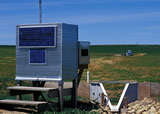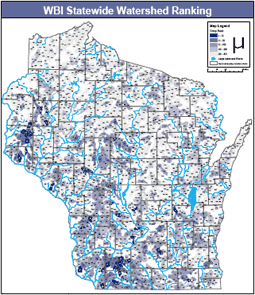
Final Report to the Natural Resource Board
The Wisconsin Buffer Initiative was a collaborative effort between a diverse group of Wisconsin citizens and UW-Madison scientists to develop recommendations for the Wisconsin DNR on how riparian buffers can be part of a larger conservation system to address agricultural nonpoint source pollution.

WBI photos by Bill Pielsticker.
Download: Final Report to the Natural Resources Board
The report is available in Adobe Acrobat PDF format.
A free Adobe Acrobat reader can be found here.
What is The Wisconsin Buffer Initiative (WBI)?
Controversy in the 2000-2001 legislative process concerning the role of buffers in the redesign of the Wisconsin non-point pollution control program led to the development of the Wisconsin Buffer Initiative. The University of Wisconsin, College of Agricultural and Life Sciences (UW-CALS) was asked by the Wisconsin Department of Natural Resources (DNR) in March of 2002 to provide an overview of the science behind riparian buffers. An ad hoc committee of scientists, agency staff (federal and state), agricultural groups, and environmental organizations convened to develop this report.A report (Word document) from the UW-CALS ad hoc committee, and a 700 item scientific bibliography, was given to the DNR in early May, 2002. It emphasized an adaptive management approach based on sound and applicable science to guide the policy process. The DNR Natural Resources Board, in consultation with key legislators, passed a resolution supporting the ad hoc committee's recommendations while asking UW-Madison to conduct the necessary research that would allow an adaptive management approach to riparian buffers. UW-CALS was asked to provide the leadership in this effort with a final report to be delivered to the Natural Resources Board on or before December 31, 2005. The Wisconsin Buffer Initiative Advisory Committee was developed in response to this charge. As described under The WBI Process, this committee was composed of representatives of all the vested interests who had been involved in the earlier controversy as well as other groups who expressed an interest in this process.
Early discussions by the WBI Advisory Committee established a "philosophical" framework that guided future efforts, and upon which the research agenda would be developed. Some of the core themes that characterized these discussions are as follows:
- The need to recognize the significant diversity of agricultural landscapes and production systems found in Wisconsin. Uniform standards or "technical fixes" cannot adequately address this diversity in an environmentally and economically sound fashion.
- In recognition of this diversity, the WBI needs to insure that appropriate research questions are framed in such a way that any resulting research is proportional to need.
- WBI recommendations need to recognize that small proportions of the agricultural landscape contribute disproportionate amounts of the pollutants that riparian buffers are intended to address.
- The focus of WBI research activities should be based on a priority basis. How do we achieve the greatest gains in water quality with the lowest possible investment in public funds? What research is needed to answer this question?
- A very significant amount of scientific research (basic and applied) has already been conducted regarding the design, placement and functioning of riparian buffers. The charge to the WBI is not to "re-invent the wheel," but to build on this significant scientific literature in a creative and innovative fashion.
The WBI Advisory Committee established four sub-committees that worked to address the following questions that were derived from this framework:
- Where are buffers most needed across the diverse land use types and landscapes of Wisconsin ?
- What types of buffers and other conservation practices are needed in these specific locations?
- What are the consequences when buffers and associated conservation practices are installed in these specific locations?
- What will be needed to get these buffer conservation systems into these specific locations?
This website provides a transparent view of the entire scientific process which encompassed the Wisconsin Buffer Initiative. It offers current and continuously evolving insight to the research and presents all perspectives relative to the original charge from the Natural Resources Board as thoroughly as possible.
What can I do at this site?
- Learn more about buffers and the issues surrounding their installation.
- Learn about the collaborative process taking place to find a middle ground for buffer installation.
- Take a close look at the science involved in preventing runoff.
- Meet and learn about the many people and institutions involved in the WBI.


